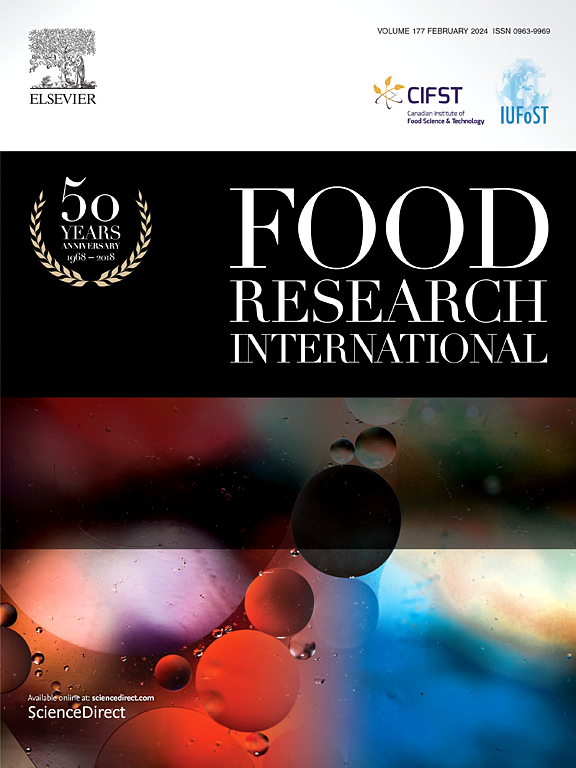Metabolomics combined with network pharmacology reveals the regional and variety heterogeneity of grape metabolites and their potential antioxidant mechanisms
IF 7
1区 农林科学
Q1 FOOD SCIENCE & TECHNOLOGY
引用次数: 0
Abstract
China is one of the world's three major grape-producing regions. However, limited research has focused on the differential metabolites of cross-regional and cross-varietal grapes, and the specific metabolites responsible for their pharmacological effects. Thus, this study comparatively analyzed the antioxidant activities and metabolite compositions of grapes from different regions and varieties to explore the potential antioxidant mechanisms of flavonoid metabolites. The results revealed that the production region primarily influenced the 2,2-Diphenyl-1-picrylhydrazyl (DPPH) of grapes, whereas variety significantly affected the ferric ion reducing antioxidant power (FRAP). Both region and variety had highly significant effects on the total phenolic content (TPC) and total flavonoid content (TFC) of grapes (P < 0.001) and showed significant effects on the 2,2′-Azino-bis (3-ethylbenzothiazoline-6-sulfonic acid) (ABTS+) and grape metabolites (P < 0.05). However, variety exerted a stronger influence on metabolite composition than region (P < 0.001). Flavonoid metabolites have emerged as key antioxidants, with compounds such as kaempferol, fisetin, and 6-hydroxyluteolin playing critical roles. These metabolites primarily exert their antioxidant effects through signaling pathways, notably the PI3K-Akt pathway. Among all samples, Xinjiang's ‘Summer Black’ grapes showed the best antioxidant capacity. These findings provide insights into the biochemical basis underlying the differences grapes in China, offering a theoretical foundation for further research on the pharmacological efficacy and antioxidant mechanisms of secondary metabolites in Chinese grapes.

代谢组学结合网络药理学揭示了葡萄代谢物的区域和品种异质性及其潜在的抗氧化机制
中国是世界三大葡萄产区之一。然而,关于跨地域、跨品种葡萄的差异代谢物,以及导致其药理作用的特定代谢物的研究有限。因此,本研究比较分析了不同地区和品种葡萄的抗氧化活性和代谢物组成,探讨了类黄酮代谢物的潜在抗氧化机制。结果表明,产区主要影响葡萄的2,2-二苯基-1-苦酰肼(DPPH),而品种显著影响铁离子还原抗氧化能力(FRAP)。地域和品种对葡萄总酚含量(TPC)和总黄酮含量(TFC)均有极显著影响(P <;0.001),对2,2 ' -氮基-双(3-乙基苯并噻唑啉-6-磺酸)(ABTS+)和葡萄代谢产物(P <;0.05)。然而,品种对代谢物组成的影响强于区域(P <;0.001)。类黄酮代谢物已成为关键的抗氧化剂,其中山奈酚、非瑟酮和6-羟基木犀草素等化合物起着关键作用。这些代谢物主要通过信号通路发挥抗氧化作用,尤其是PI3K-Akt通路。其中,新疆“夏黑”葡萄抗氧化能力最强。这些发现为进一步研究中国葡萄次生代谢产物的药理功效和抗氧化机制提供了理论基础。
本文章由计算机程序翻译,如有差异,请以英文原文为准。
求助全文
约1分钟内获得全文
求助全文
来源期刊

Food Research International
工程技术-食品科技
CiteScore
12.50
自引率
7.40%
发文量
1183
审稿时长
79 days
期刊介绍:
Food Research International serves as a rapid dissemination platform for significant and impactful research in food science, technology, engineering, and nutrition. The journal focuses on publishing novel, high-quality, and high-impact review papers, original research papers, and letters to the editors across various disciplines in the science and technology of food. Additionally, it follows a policy of publishing special issues on topical and emergent subjects in food research or related areas. Selected, peer-reviewed papers from scientific meetings, workshops, and conferences on the science, technology, and engineering of foods are also featured in special issues.
 求助内容:
求助内容: 应助结果提醒方式:
应助结果提醒方式:


